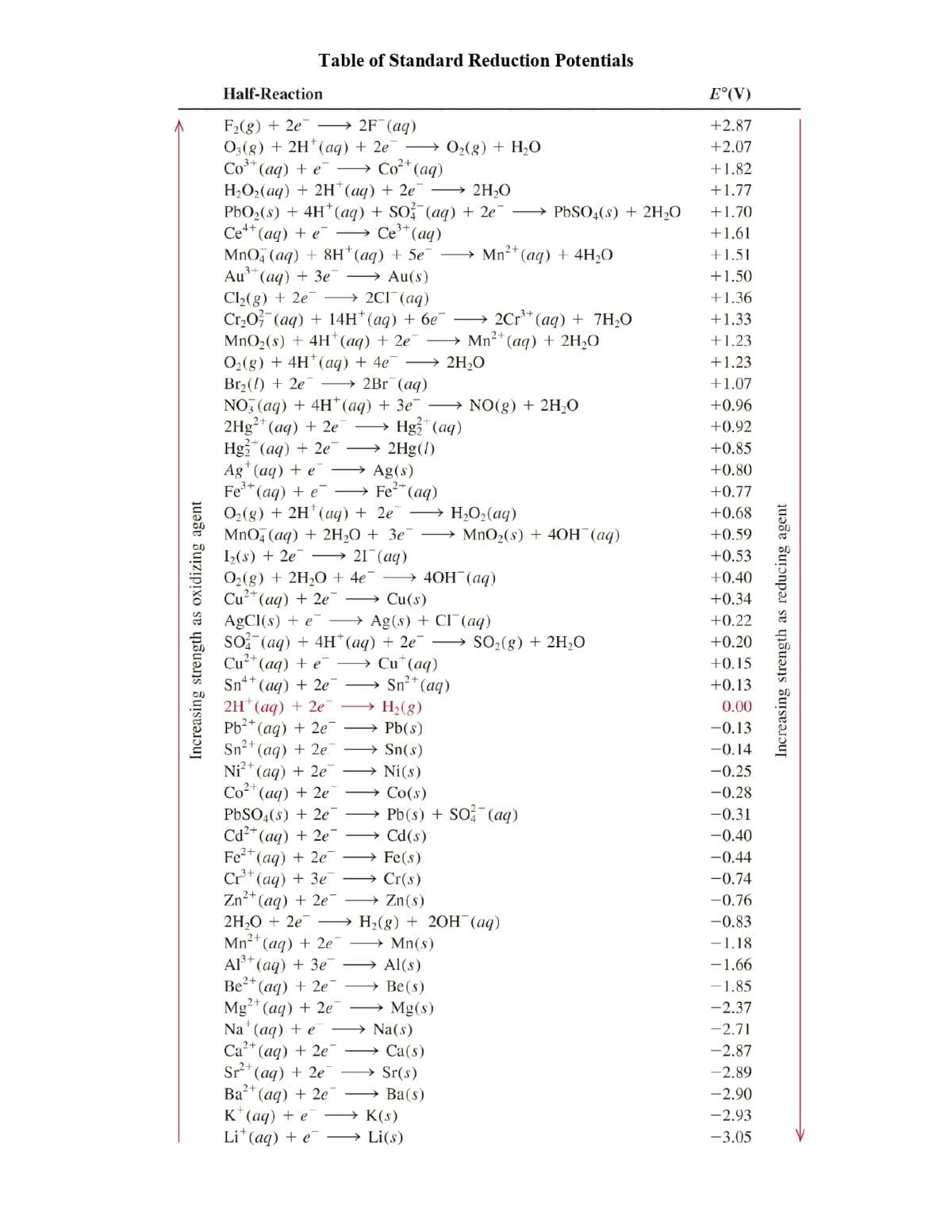For the cell reaction given: 1. How many moles of electrons are transferred overall? 2. What is the E°cell? +0.55 V +4.19 V +2.09 V ‒0.55 V None of the given. 3. If [Mg²⁺] = 0.10 M and both [Co²⁺] and [Co³⁺] = 0.50 M, what is Ecell? +4.22 V +2.12 V ‒0.52 V +0.58 V None of the given.
For the cell reaction given: 1. How many moles of electrons are transferred overall? 2. What is the E°cell? +0.55 V +4.19 V +2.09 V ‒0.55 V None of the given. 3. If [Mg²⁺] = 0.10 M and both [Co²⁺] and [Co³⁺] = 0.50 M, what is Ecell? +4.22 V +2.12 V ‒0.52 V +0.58 V None of the given.
Chemistry: Principles and Practice
3rd Edition
ISBN:9780534420123
Author:Daniel L. Reger, Scott R. Goode, David W. Ball, Edward Mercer
Publisher:Daniel L. Reger, Scott R. Goode, David W. Ball, Edward Mercer
Chapter18: Electrochemistry
Section: Chapter Questions
Problem 18.59QE
Related questions
Question
For the cell reaction given:
1. How many moles of electrons are transferred overall?
2. What is the E°cell?
+0.55 V
+4.19 V
+2.09 V
‒0.55 V
None of the given.
3. If [Mg²⁺] = 0.10 M and both [Co²⁺] and [Co³⁺] = 0.50 M, what is Ecell?
+4.22 V
+2.12 V
‒0.52 V
+0.58 V
None of the given.

Transcribed Image Text:Increasing strength as oxidizing agent
Table of Standard Reduction Potentials
Half-Reaction
F₂(g) + 2e →→→ 2F¯ (aq)
O3(g) + 2H¹ (aq) + 2e¯ → O₂(g) + H₂O
Co³+ (aq) + e → Co (aq)
H₂O₂(aq) + 2H(aq) + 2e
→ 2H₂O
PbO₂ (s) + 4H+ (aq) + SO²(aq)
Ce+ (aq) + e
Ce³+ (aq)
+ 2e¯ →→→ PbSO4(s) + 2H₂O
2+
→Mn²+ (aq) + 4H₂O
MnO4 (aq) + 8H+ (aq) + 5e7
Au³+
(aq) + 3e - Au(s)
Cl₂(g) + 2e →→→ 2Cl¯¯(aq)
3+
Cr₂O² (aq) + 14H*(aq) + 6e¯
2Cr³+ (aq) + 7H₂O
2+
MnO₂ (s) + 4H+ (aq) + 2e7
→→Mn²+
(aq) + 2H₂O
O₂(g) + 4H+ (aq) + 4e¯ →→→ 2H₂O
Br₂() +2e7 →→→→2Br (aq)
NO3(aq) + 4H+ (aq) + 3e¯→→→→→ NO(g) + 2H₂O
2Hg²+ (aq) + 2e
Hg2+ (aq)
Hg2+ (aq) + 2e
→ 2Hg(1)
Ag+ (aq) + e →
Ag(s)
Fe³+ (aq) + e→→→→→ Fe²+ (aq)
O₂(g) + 2H+ (aq) + 2e7 →→→→H₂O₂(aq)
MnO4 (aq) + 2H₂O + 3e7
1₂(s) + 2e
21 (aq)
O₂(g) + 2H₂O + 4e¯
→→→40H(aq)
Cu(s)
Cu²+ (aq) + 2e
AgCl(s) + e
Ag(s) + Cl(aq)
SO (aq) + 4H+ (aq) + 2e¯
Cu²+ (aq) + e
Cu (aq)
Sn4+
(aq) + 2e
2H(aq) + 2e
Pb²+ (aq) + 2e-
Sn²+ (aq) + 2e
Ni²+ (aq) + 2e
Co²+
(aq) + 2e
PbSO4(s) + 2e
Cd²+ (aq) + 2e
Fe²+ (aq) + 2e
Cr³+ (aq) + 3e
Zn²+ (aq) + 2e
2H₂O + 2e
Mn²+ (aq) + 2e
A1³+ (aq) + 3e¯
Be²+ (aq) + 2e
Mg2+ (aq) + 2e
Na (aq) + e
2+
Ca²+ (aq) + 2e
Sr²+ (aq) + 2e
Ba²+ (aq) + 2e
K+ (aq) + e → K(s)
Li (aq) + e →
Li(s)
Sn²+ (aq)
H₂(g)
Pb(s)
Sn(s)
Ni(s)
Co(s)
→ Pb(s) + SO² (aq)
Cd(s)
Fe(s)
Cr(s)
Zn(s)
H₂(g) + 2OH(aq)
→→ Mn(s)
Al(s)
Be(s)
Mg(s)
Na(s)
MnO₂ (s) + 40H(aq)
SO₂(g) + 2H₂O
Ca(s)
Sr(s)
→Ba(s)
E°(V)
+2.87
+2.07
+1.82
+1.77
+1.70
+1.61
+1.51
+1.50
+1.36
+1.33
+1.23
+1.23
+1.07
+0.96
+0.92
+0.85
+0.80
+0.77
+0.68
+0.59
+0.53
+0.40
+0.34
+0.22
+0.20
+0.15
+0.13
0.00
-0.13
-0.14
-0.25
-0.28
-0.31
-0.40
-0.44
-0.74
-0.76
-0.83
-1.18
-1.66
-1.85
-2.37
-2.71
-2.87
-2.89
-2.90
-2.93
-3.05
Increasing strength as reducing agent

Transcribed Image Text:For the cell reaction
3+
Mg(s) + Co³+ (aq) → Mg²+ (aq) + Co²+ (aq)
Expert Solution
This question has been solved!
Explore an expertly crafted, step-by-step solution for a thorough understanding of key concepts.
Step by step
Solved in 2 steps with 2 images

Knowledge Booster
Learn more about
Need a deep-dive on the concept behind this application? Look no further. Learn more about this topic, chemistry and related others by exploring similar questions and additional content below.Recommended textbooks for you

Chemistry: Principles and Practice
Chemistry
ISBN:
9780534420123
Author:
Daniel L. Reger, Scott R. Goode, David W. Ball, Edward Mercer
Publisher:
Cengage Learning

Principles of Modern Chemistry
Chemistry
ISBN:
9781305079113
Author:
David W. Oxtoby, H. Pat Gillis, Laurie J. Butler
Publisher:
Cengage Learning

Chemistry: The Molecular Science
Chemistry
ISBN:
9781285199047
Author:
John W. Moore, Conrad L. Stanitski
Publisher:
Cengage Learning

Chemistry: Principles and Practice
Chemistry
ISBN:
9780534420123
Author:
Daniel L. Reger, Scott R. Goode, David W. Ball, Edward Mercer
Publisher:
Cengage Learning

Principles of Modern Chemistry
Chemistry
ISBN:
9781305079113
Author:
David W. Oxtoby, H. Pat Gillis, Laurie J. Butler
Publisher:
Cengage Learning

Chemistry: The Molecular Science
Chemistry
ISBN:
9781285199047
Author:
John W. Moore, Conrad L. Stanitski
Publisher:
Cengage Learning

Chemistry
Chemistry
ISBN:
9781305957404
Author:
Steven S. Zumdahl, Susan A. Zumdahl, Donald J. DeCoste
Publisher:
Cengage Learning


Chemistry: Principles and Reactions
Chemistry
ISBN:
9781305079373
Author:
William L. Masterton, Cecile N. Hurley
Publisher:
Cengage Learning